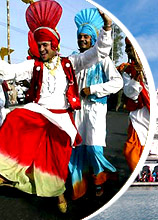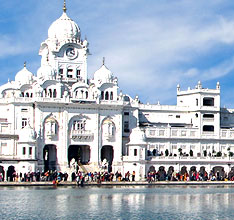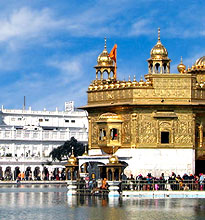 Time: January 13th
Time: January 13th Venue: All over Punjab
Significance: Harvest Festival
Highlights: Prayer to Lord Agni, bonfire, Bhangra and Gidda dance, traditional feast
Lohri is the winter harvest festival of Punjab, celebrated widely throughout the state. It is the festival of fertility and is associated with the worship of the God of Fire (Lord Agni). According to the Hindu calendar, Lohri falls on 13th January every year, at a time when the earth is closest to the sun. It marks the end of winter, the last day of Paush and the beginning of spring season. The festival provides the perfect occasion to indulge in relaxation, after the hard toil of winters. Around this time, the crops are harvested and gathered.
Legends
Lohri is associated with the tale of a Muslim dacoit, Dulla Bhatti. He was a highway robber during the reign of Emperor Akbar. He robbed only the rich and gave the money thus obtained to the poor. At the same time, he rescued many Hindu girls from being sold in the slave market. Within no time, he became a hero for the poor people, whose acts of valor came to be sung in the Lohri songs. Lohri is celebrated to express gratitude to this 'Robin hood’.
Origin
There are diverse views regarding the origin of the name "Lohri”. Some believe it is derived from the name of Sant Kabir's wife Lohi, since in rural Punjab, the festival is pronounced as such. Some others are of the opinion that it comes from the word 'loh’, a thick iron sheet (tawa) used to make chapattis for community feasts. Another opinion runs that Holika and Lohri are sisters. While the former perished in the Holi fire, the latter survived. Thus, the opinion differs about the origin of the name "Lohri”.
Celebration
Lohri begins with children going from one house to another in the morning, singing folk songs in praise of Dulla Bhatti. They are given some sweets, gifts and occasionally money at every house they visit. These collections are called Lohri and are distributed at night, with some of the collections being offered to the sacred fire. In the evening, people light the sacred bonfire. They go around the fire three times, singing songs and offering popcorns, peanuts, rayveri and sweets to the fire. Finally, a mixture of water and unboiled milk, called kachhi lassi, is poured all around the fire. The offerings symbolize their gratitude to Lord Agni, the God of Fire, for abundant crops.
After the ritual offerings are made, Punjabis perform bhangra and gidda on the beat of the dhol (Indian drum), around the fire. They dance till the fire subsides. People take dying embers of the fire to their homes. Later, a prasad made out of til, peanuts, rayveri, puffed rice, popcorn, moongphali, gajak and sweets is distributed. On Lohri, Punjabi people wear colorful traditional clothes and actively participate in singing and dancing. Mouth-watering traditional local delicacies rule the day. The dinner after the puja consists of the famous makki ki roti with sarsaon ki saag and rau di kheer, along with other items.
The joy of Lohri doubles in a family where a marriage had been solemnized recently or a baby has been delivered in the recent past. Such families generally organize a grand feast on the occasion, inviting many people and preparing the most luscious of dishes. The newborn child or the recently married couple is also made to participate in the puja, as this is regarded as very auspicious. Lohri is celebrated in many other parts of the country as well, though with different names. It is called Pongal in Tamil Nadu, Bihu in Assam, Bhogi in Andhra Pradesh and Sankranti in Karnataka, Bihar and Uttar Pradesh.











